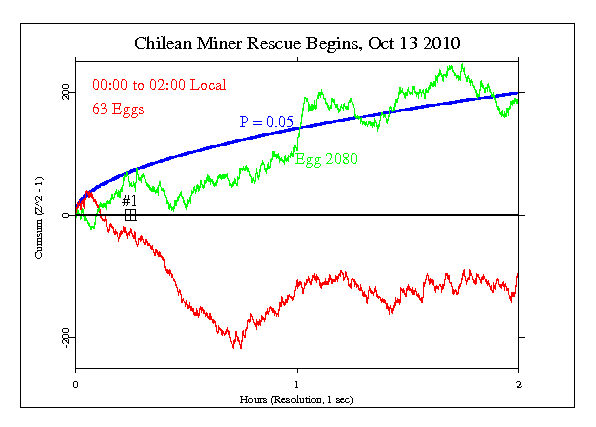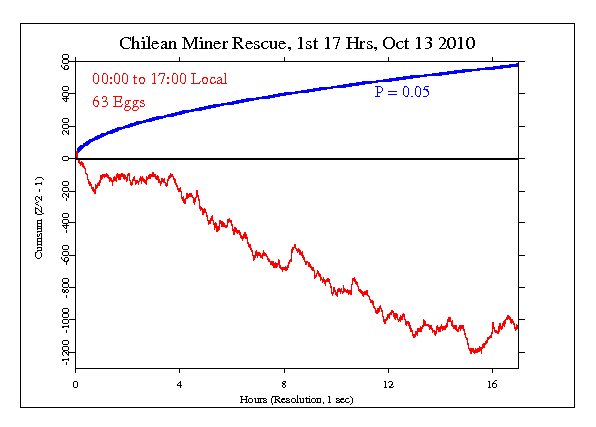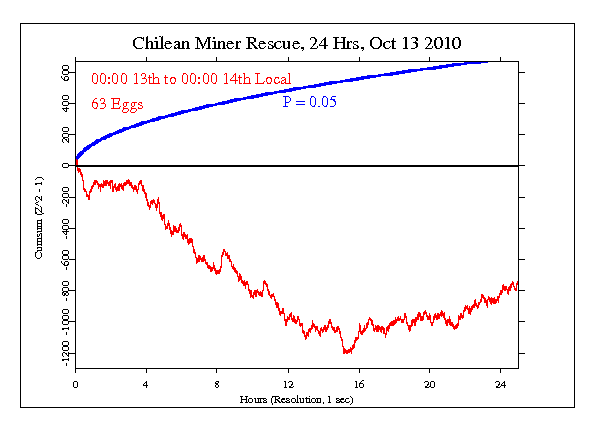Chilean Miners Rescued |
|
From Copiapo, Chile, comes good news about a remarkable rescue. A major mining cave-in accident trapped 33 miners who have been half a mile underground for more than two months. We learned that the miners were alive on August 23, and now (October 13) their rescue is the focus of news media around the world. Many people have a profound reaction and see this as a great human event, almost a miracle. It is clearly an appropriate global event for the GCP. Fernando Erbetta Doyharcabal wrote, "Well, it seems the day has come. According to authorities, the operations to rescue the 33 trapped miners could begin today around 20:00 PM Chilean time (23:00 UTC). ... The number of world news media that have come to cover the rescue has already increased to almost 200 (!). That means only a few countries in the world (if any) will not know about what it will happen here. Could this be defined as a "global event"? The GCP network will tell." Diana Cammack sent a note to say, "The rescue of these Chilean miners ought to provide EGG with a great opportunity to watch a long-term, public, global event.... It will be interesting to see how the signal fluctuates over the time of the rescue... and if it changes according to where the Egg is placed." And Hans Wendt suggested, "Judging from a few samples of international press and TV reports I ... see [the] widespread knowledge, resonance and interest in the Chilean miners' rescue yesterday as a critical event. If included, maybe use the time of the first man's capsule emerging at the surface?" The first of 33 miners surfaced just after midnight local Chilean time, October 13, at 00:13, after 69 days underground. News reports described a very sophisticated and careful operation. The rescue capsule was sent down empty and with sandbags inside to test the operation. Then a paramedic descended to help determine who would come out and in what order. "The healthiest and fittest miners will be rescued first in case the capsule runs into any problems. Then after the first four or five, the weakest miners will be brought out." Each ride to the top takes about 15 minutes. The GCP event was set to begin at midnight (03:00 UTC), just before the first miner emerged at 00:13, (marked in the graph) and continue for two hours, attempting to capture the extraordinary attention and emotional engagement of the successful rescue. The result is Chisquare 7109.9 on 7200 df, for p = 0.791 and Z = -0.810. The figure also includes data for Egg 2080 (shown in green), which is located in Santiago, Chile. As usual according to the GCP protocol, the formal result is for the whole network (shown in red), but it is interesting to compare the local, most obviously engaged node. The trends are opposite (as we also saw in the earlier GCP event when the world learned the miners were alive.) 
As suggested earlier, this is an unusual opportunity to follow the response of the network over a long period of engagement. Each of the 33 miners comes up in a capsule called "Phoenix" one at a time, and because the distance is so great it takes more than 15 minutes for the traverse. Sending the capsule back down takes a bit longer, and checking and monitoring the process adds time, so that it takes about 45 minutes for each miner. What we see in the longer term is a virtually linear slope in the cumulative deviation trace. The deviation from expectation is nearly constant over many hours -- I am writing this after 17 hours since the first miner emerged. The graph is striking indeed. The deviation at this point is more than 3 standard deviations.

The last of the miners was at the surface around 10:00, and the six rescuers who had gone down to help were brought up ovre the next two hours, with the last emerging at 12:32 on the 14th. It took just over 24 hours for the entire operation. The next figure shows 25 hours, including 15 minutes before the first and about 30 minutes after the last man emerged. 
It is important to keep in mind that we have only a tiny statistical effect, so that it is always hard to distinguish signal from noise. This means that every "success" might be largely driven by chance, and every "null" might include a real signal overwhelmed by noise. In the long run, a real effect can be identified only by patiently accumulating replications of similar analyses.
|